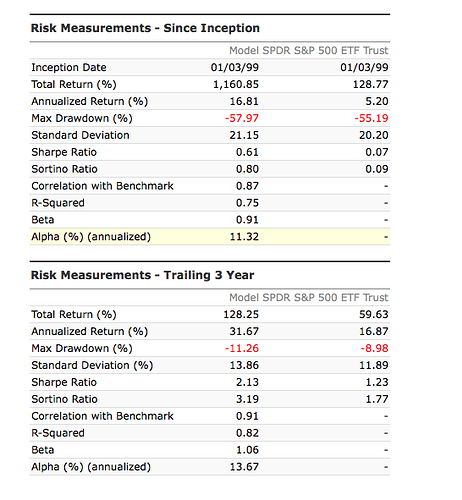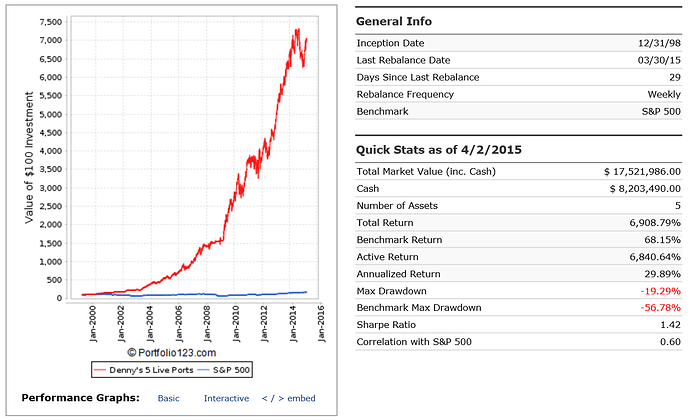Coog,
Some quick / random thoughts:
First you have to match any system to your goals and belief system. If you only believe in long-hold systems, that’s all you should invest in. Matching personal belief systems with the endless number of investment systems out there matters - otherwise, you won’t stick with them when times get tough - and switching investment philosophy too much is a recipe for large underperformance.
Having said that, I’d suggest you think in buckets:
- Income (your salary and/or income from rent generating assets that are fairly stable - like rental properties or short term, hi quality bonds that you can hold to maturity (not funds)).
- Short-term emergency cash needs (cash you are likely to need and/or might need in emergencies in the next 2-5 years if you lost your job or had major health / life event).
- Passive long term investment dollars that are invested and left for 2-5 years at a time. This would be lower turnover ETF’s and long-hold stock and bond positions mostly.
- Active, more ‘speculative’ trading based systems or ‘alternative’ return driver systems. I have posted too much on this in past, to go into it here, but real estate loans, CTA’s, higher turn p123 systems, etc. can all fit in here - as can hedged systems and long-short and market neutral funds.
What matters from a risk control standpoint is how the total portfolio works together. Certain trading systems have held up in terms of both negative correlations and positive returns in peak market down and stress events. If your income is very high relative to portfolio size and your job is very stable, you can take much more risk in your portfolio construction. If your salary is low relative to your savings, you need much more diversification and more stability as your margin for recovery is lower.
There is, of course, a global investment market. Investment in US publicly listed equities is a fairly small part of that total universe. However, until your portfolio is very large, it doesn’t make sense to move far from cash, bonds and stocks and infrequent work on it. It can become a huge life distraction relative to any additional earning potential.
The portfolio construction problem above is the most important initial choice. Then it gets down to how to execute each bucket to the best of your ability given the max. amount of time you are willing to put in.
If you want to put in under 5 hours / week, you potentially could / should only consider longer hold systems with lower turn. Even on these, you can split your turn rules - there is no point to holding losers in higher liquidity stocks if you can both benefit from the tax loss, can trade cheaply and can replace in a higher ranked stock. As liquidity falls and your time investment falls, you need to decide on the tradeoffs. Over my years investing, I have tended to use some active managers, some ETF’s and cash, and some more active systems I build myself. It works for my risk tolerance. Most of my systems use some sector constraints.
As far as if it’s possible to predict winning funds, I’ve both read / seen a lot of research and tried to do it myself. It’s possible, but as the time frame lengthens, it gets much harder (it’s more easy to predict manager outperformance over next 3 months then over next 3 years). And it requires a lot of time and an ‘area of narrow focus / expertise.’ Also FYI: Many top funds have lower turn for many other reasons than optimizing AR%, i.e. many family offices or institutions have IP policy limits on turnover and/or are trying to max. after tax returns.
The ‘best’ managers in theory are not in mutual funds, they are in hedge funds and long-short and other active management. But, while the top 10% are likely the very best traders in the world. the average manager in the alt. space is even worse (in my opinion) then the average mutual fund guy after fees and taxes - and it’s not worth looking at till you have $5MM or more in assets.
R2G single system evalution is likely harder to do well, for many reasons, then alternative asset manager evaluation.
Also, for any P123 person looking to maximize return and putting a high % of the total port. into very active systems, taxes are likely to become a huge hurdle to overcome. Unless you want to make trading and system development your full time job, success (significant total return boost) at a high alpha level over lower cost, lower tax systems is unlikely. However, returns on a risk-adjusted basis may be smoothed and improved and DD’s lessened (in extreme movements) by using the above buckets with either systems you’ve built and really believe in, or a relatively low cost bundle of R2G’s to go with the other buckets. Again, no guarantees, but I feel better and sleep better at least knowing how I’ve built the total portfolio for a reason.
Good luck.
Best,
Tom


